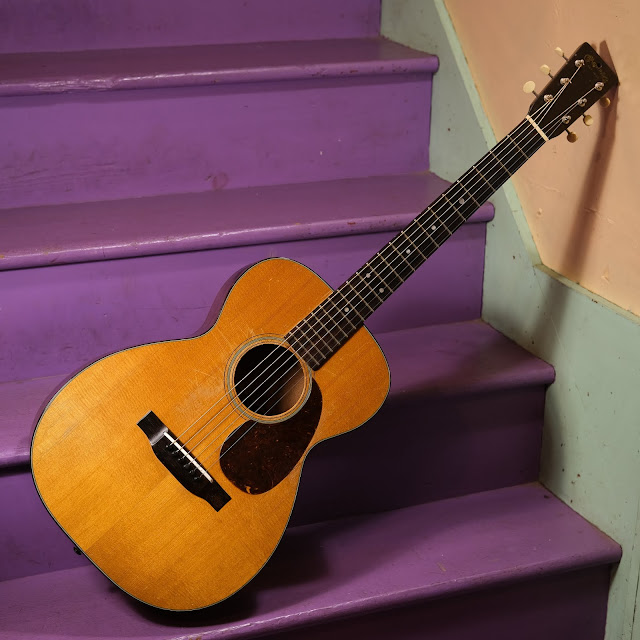1946 Martin 0-18 Flattop Guitar
The vast majority of old Martin 0-18s I've had through the shop aren't as clean as this little guy because they've been played into the dirt. Sure it's got pickwear and minor scratches all over (so few old guitars don't), but it lacks cracks save for a small one to the treble-side of the pickguard and it's all-original except for its pins and saddle.
This is a good example of a '40s size 0, too -- it has punch and guts far above its weight/size and a nice, woody, folksy sound that's not too complicated. It records beautifully for flatpicking and fingerpicking and has that sweetness to the top-end that I associate with '40s Martins. The neck is also killer -- it's a medium-heft C/soft-V shape that fills the hand nicely and isn't too petite like on many later instruments. This is my kind of neck.
Work included: a neck reset, fret level/dress, recut of the saddle slot (had to make it a little wider to the front to get compensation correct), cleats for the small hairline crack next to the pickguard, cleaning, and a good setup. The neck is straight and action is spot-on 3/32" EA and 1/16" DGBE at the 12th fret, strung with normal 54w-12 gauges.
Scale length: 24 7/8"
Nut width: 1 11/16"
String spacing at nut: 1 1/2"
String spacing at bridge: 2 3/16"
Body length: 18 1/4"
Lower bout width: 13 5/8"
Waist width: 8"
Upper bout width: 10"
Side depth at endpin: 4 3/16"
Top wood: solid spruce
Back/sides wood: solid mahogany
Neck wood: mahogany
Bracing type: x-braced
Fretboard: Brazilian rosewood, original nut
Bridge: Brazilian rosewood, bone saddle
Neck feel: medium soft-V shape, ~14" board radius
Condition notes: the fretboard extension dips a little down over the body after the reset (I do this so it doesn't "ski-jump" in the more humid months of the year when the top swells), the saddle and bridge pins/endpin are replacements, and there's mild wear-and-tear throughout the finish. And last but not least -- someone drilled a hole in the headstock to put a strap through!
It comes with: a nondescript chip case.
Note the hole drilled in the headstock top -- presumably to hang a strap from.
The frets are lower than original spec but in good order and with some meat left on them.
You can see the 2" repaired hairline crack to the side of the pickguard in this pic.
When Martin installed the bridge, the saddle slot was almost 1/16" too far to the rear. I widened the slot forward so I could get a wider saddle with proper compensation in it. The original saddle had been cut-down flush with the top of the bridge when this came in, anyhow.
Gosh, I love the look of that browny tortoise binding.


















Comments